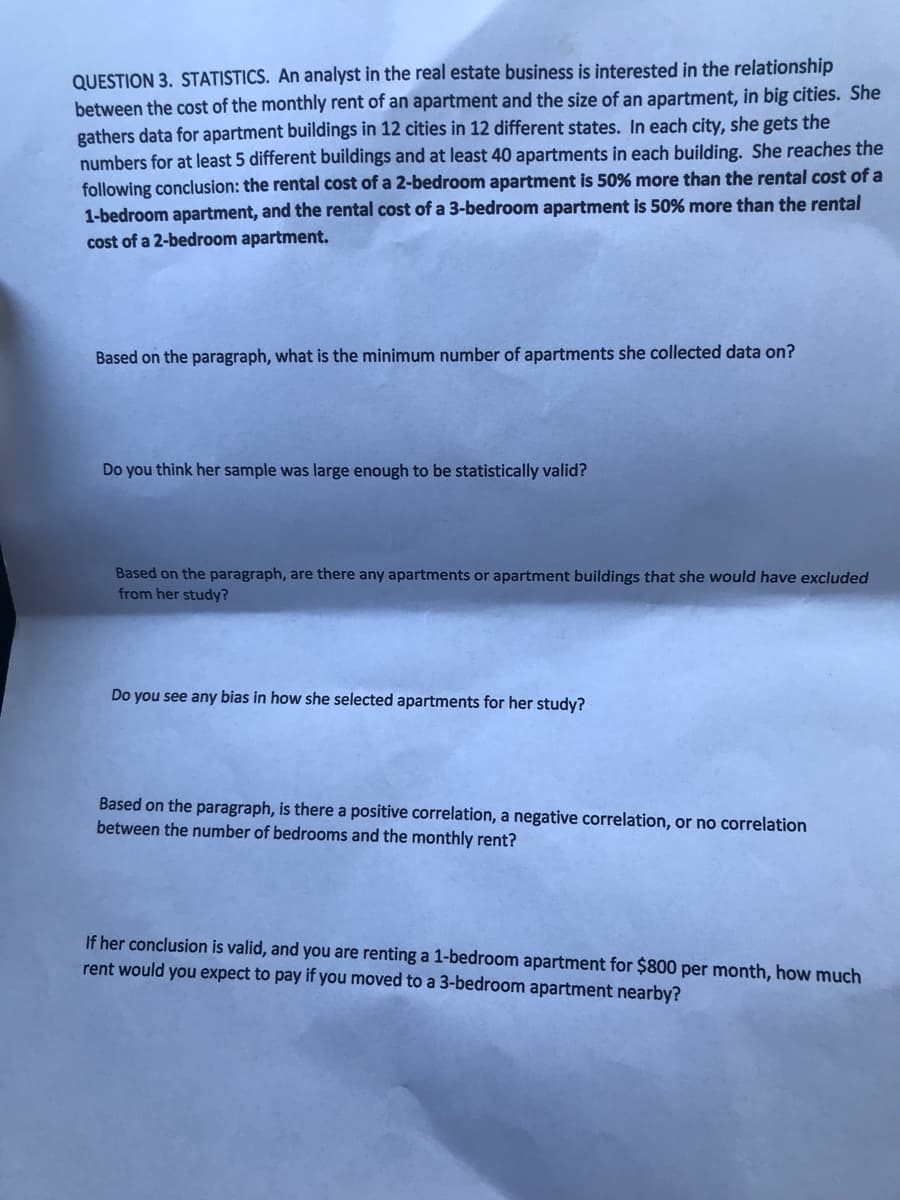QUESTION 3. STATISTICS. An analyst in the real estate business is interested in the relationship between the cost of the monthly rent of an apartment and the size of an apartment, in big cities. She gathers data for apartment buildings in 12 cities in 12 different states. In each city, she gets the numbers for at least 5 different buildings and at least 40 apartments in each building. She reaches the following conclusion: the rental cost of a 2-bedroom apartment is 50% more than the rental cost of a 1-bedroom apartment, and the rental cost of a 3-bedroom apartment is 50% more than the rental cost of a 2-bedroom apartment. Based on the paragraph, what is the minimum number of apartments she collected data on? Do you think her sample was large enough to be statistically valid? Based on the paragraph, are there any apartments or apartment buildings that she would have excluded from her study?
QUESTION 3. STATISTICS. An analyst in the real estate business is interested in the relationship between the cost of the monthly rent of an apartment and the size of an apartment, in big cities. She gathers data for apartment buildings in 12 cities in 12 different states. In each city, she gets the numbers for at least 5 different buildings and at least 40 apartments in each building. She reaches the following conclusion: the rental cost of a 2-bedroom apartment is 50% more than the rental cost of a 1-bedroom apartment, and the rental cost of a 3-bedroom apartment is 50% more than the rental cost of a 2-bedroom apartment. Based on the paragraph, what is the minimum number of apartments she collected data on? Do you think her sample was large enough to be statistically valid? Based on the paragraph, are there any apartments or apartment buildings that she would have excluded from her study?
Functions and Change: A Modeling Approach to College Algebra (MindTap Course List)
6th Edition
ISBN:9781337111348
Author:Bruce Crauder, Benny Evans, Alan Noell
Publisher:Bruce Crauder, Benny Evans, Alan Noell
Chapter5: A Survey Of Other Common Functions
Section5.3: Modeling Data With Power Functions
Problem 6E: Urban Travel Times Population of cities and driving times are related, as shown in the accompanying...
Related questions
Question
100%

Transcribed Image Text:QUESTION 3. STATISTICS. An analyst in the real estate business is interested in the relationship
between the cost of the monthly rent of an apartment and the size of an apartment, in big cities. She
gathers data for apartment buildings in 12 cities in 12 different states. In each city, she gets the
numbers for at least 5 different buildings and at least 40 apartments in each building. She reaches the
following conclusion: the rental cost of a 2-bedroom apartment is 50% more than the rental cost of a
1-bedroom apartment, and the rental cost of a 3-bedroom apartment is 50% more than the rental
cost of a 2-bedroom apartment.
Based on the paragraph, what is the minimum number of apartments she collected data on?
Do you think her sample was large enough to be statistically valid?
Based on the paragraph, are there any apartments or apartment buildings that she would have excluded
from her study?
Do you see any bias in how she selected apartments for her study?
Based on the paragraph, is there a positive correlation, a negative correlation, or no correlation
between the number of bedrooms and the monthly rent?
If her conclusion is valid, and you are renting a 1-bedroom apartment for $800 per month, how much
rent would you expect to pay if you moved to a 3-bedroom apartment nearby?
Expert Solution
This question has been solved!
Explore an expertly crafted, step-by-step solution for a thorough understanding of key concepts.
Step by step
Solved in 5 steps

Recommended textbooks for you

Functions and Change: A Modeling Approach to Coll…
Algebra
ISBN:
9781337111348
Author:
Bruce Crauder, Benny Evans, Alan Noell
Publisher:
Cengage Learning

Functions and Change: A Modeling Approach to Coll…
Algebra
ISBN:
9781337111348
Author:
Bruce Crauder, Benny Evans, Alan Noell
Publisher:
Cengage Learning